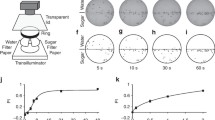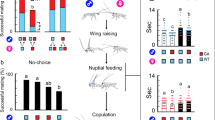Summary
A quantitative behavioral assay was developed for the measurement of taste responses to sugars inDrosophila. The amount of the intake of a sugar solution was measured colorimetrically after homogenization of flies which had consumed sugar solutions mixed with a food-dye. A two-choice method was utilized to determine the taste sensitivity to sugars. Two kinds of sugar solutions were marked with either blue or red food-dye and placed alternately in the wells of a micro test plate. Flies were allowed to choose between the two sugar solutions. By classifying and counting the coloured flies, the relative taste sensitivity could be determined. Employing these methods, a genetic dimorphism in the taste sensitivity to trehalose was found among some laboratory strains ofDrosophila melanogaster. No difference in the taste sensitivity to glucose, fructose and sucrose was found between the trehalose high-sensitivity (T-1) and the low-sensitivity (Oregon-R) strains. Trehalose concentration equivalent to 2 mmol/1 sucrose, in terms of stimulating activity, was 57 mmol/1 inOregon-R and was 10 mmol/1 inT-1. Genetic analysis showed that theTre gene, whose locus is closely linked tocx (13.6) on theX chromosome, is responsible for the difference in the taste sensitivity to trehalose.
Similar content being viewed by others
References
Adler J (1975) Chemotaxis in bacteria. Annu Rev Biochem 44:431–456
Dethier VG (1956) Some factors controlling the ingestion of carbohydrates by the blowfly. Biol Bull 111:204–222
Falk R (1979) Taste responses ofDrosophila melanogaster. J Insect Physiol 25:87–91
Falk R, Atidia J (1975) Mutation affecting taste perception inDrosophila melanogaster. Nature 254:325–326
Falk R, Bleiser-Avivi N, Atidia J (1976) Labellar taste organs ofDrosophila melanogaster. J Morphol 150:327–342
Isono K, Kikuchi T (1974) Autosomal recessive mutation in sugar responseof Drosophila. Nature 248:243–244
Kalmus H (1971) Genetics of taste. In: Beidler LM (ed) Handbook of sensory physiology, vol IV/2. Springer, Berlin Heidelberg New York, pp 165–179
Klein TW, DeFries JC (1970) Similar polymorphism of taste sensitivity to PTC in mice and men. Nature 225:555–557
Lindsley DL, Grell EH (1968) Genetic variation ofDrosophila melanogaster. Carnegie Inst Wash Publ 627
Rodrigues V, Siddiqi O (1978) Genetic analysis of chemosensory pathway. Proc Indian Acad Sci 87 [B]:147–160
Tanimura T, Shimada I (1981) Multiple receptor proteins for sweet taste inDrosophila discriminated by papain treatment. J Comp Physiol 141:265–269
Tompkins L, Cadosa MJ, White FV, Sanders TG (1979) Isolation and analysis of chemosensory behavior mutants inDrosophila melanogaster. Proc Natl Acad Sci USA 76:884–887
Author information
Authors and Affiliations
Rights and permissions
About this article
Cite this article
Tanimura, T., Isono, K., Takamura, T. et al. Genetic dimorphism in the taste sensitivity to trehalose inDrosophila melanogaster . J. Comp. Physiol. 147, 433–437 (1982). https://doi.org/10.1007/BF00612007
Accepted:
Issue Date:
DOI: https://doi.org/10.1007/BF00612007




